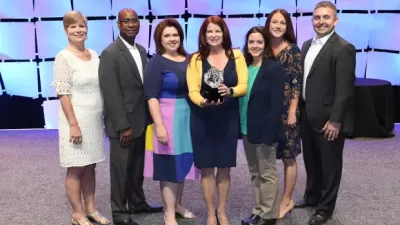Trust between the public and government agencies is low, and democracies are paralyzed without it. How can community engagement help restore trust? This post outlines the challenge and a process for solving it.

In communities across the nation, the public's trust in government is low. We've seen plenty of evidence of that in the U.S. presidential election and at the local government level as well. I want to say it's at an all-time low but I can't be sure of that.
Trust is a two-way street
The mistrust seems to be running in both directions. The public lack trust in government agencies and government agencies lack trust in the public’s ability to contribute meaningfully to decision-making. This cauldron of mistrust is the arena that planners enter when conducting community engagement.
In democracies like ours, trust is a critical currency. In many ways we are paralyzed without it. It is critical to building the necessary public and political support needed to create meaningful change in our communities. And therein lies the opportunity for community engagement practitioners.
Community engagement lies at an important nexus between the public and the government. It has the ability to either erode trust further or help restore it.
This post marks the beginning of a kind of community engagement process about community engagement. It is an open invitation to contribute to a guidebook to restoring public trust in government agencies through thoughtful community engagement. Click here to receive a copy as soon as it is released.
What follows are some recent observations on this topic from a wide variety of authors.
What power does the citizen have in the planning process?
Nothing leads to frustration and "stakeholder burnout" faster than decision makers disregarding community input. Tiago Peixoto, named alongside Barack Obama and a Google founder as one of the most innovative people in democracy, puts it this way in How to Tap the Power of the People: "The underlying concern is to make sure that the citizens’ voice has teeth. Because creating citizen participation is very easy, but what is really difficult is to make sure those things are not tokenistic, or that when citizens say something, the government does something about it."
Community engagement experts will be familiar with the "Spectrum of Public Participation," created by the International Association for Public Participation (IAP2). It lays out a range of techniques and approaches along a spectrum of increasing level of public impact or control. At the low end are techniques in categories called Inform (primarily information going out) and Consult (gather some limited public feedback), which offer limited control over the outcome. At the other end are Collaborate (partnering with the public) and, at the farthest end, Empower (placing the decision in the hands of the public).
Most planning agencies can't move all the way down this spectrum because final decision making typically rests with elected officials. At the same time, those same elected officials are keenly aware of the power of the citizen. Elections were traditionally where the public wielded their influence. Too many unacceptable decisions lead to a "throw the bums out" mentality at election time. But community input once every election cycle is an extremely blunt version of democracy.
In today's world of community engagement on every planning project we have an opportunity for a higher fidelity of democracy. Like elections, however, it's natural for the public to expect that their opinions will be affect the outcome. Otherwise, from the community's perspective, there’s no point in participating.
What Boaty McBoatface taught us about expectation management
Online engagement has opened the floodgates to more participation. With that comes more people with expectations of influence. Some styles of online community engagement feed this expectation more than others. For example, crowdsourcing platforms invite the public to nominate ideas, vote on each other's ideas and then watch the most popular ideas rise to the top.
These technologies rose rapidly in popularity among planners, but early enthusiasm seems to have waned. This disenchantment was perhaps fueled by fiascos akin to Boaty McBoatface, the case of the British government running an online crowdsourcing campaign to name a ship. The runaway favorite, "R. R. S. Boaty McBoatface" left the agency to scramble and appear to back-peddle despite making no promises to adopt the most popular name.
Clearly naming a boat and making lasting planning decisions are not in the same league of seriousness. This example does, however, point out two things: the style of engagement can lead participants to an expectation of influence and some ideas that rise to the top may be unworkable.
Bring in the experts and duck
Planning cities is enormously complicated. With so many technical, social, financial and jurisdictional factors to consider, planning options are created by teams of experts, themselves struggling to deal with the complexities. Traditionally, community engagement activities have included experts to bring credibility and guidance. The trust that experts might have enjoyed in the past seems to have withered somewhat.
Professor Tom Nichols wrote in The Federalist blog that "we have lost respect for 'experts'—those who have knowledge and/or experience in a particular field—and have replaced it with a kind of 'expertise egalitarianism' whereby everyone's opinion is given equal weight. But it is not only that the layperson's opinions are given equal weight, experts increasingly face outright hostility. Laypeople attack experts as being arrogant, elitist, and imposing, if not outright threatening, often because the expert insists he or she knows something the other does not. Even more ridiculous, rather than being viewed as helpful or even essential, expertise is viewed as harmful or even antithetical to community participation."
To some extent, the experts might have brought some of this frustration on themselves by touting their credentials, talking down to residents and failing to truly listen to citizens' concerns.
Planners are experts too and thus can suffer the same fate. "The Fall of Planning Expertise," Reuben Duerte writes, "to anyone who has actually attended a community meeting, a planner's advice and recommendation are frequently overridden by those who know very little on the range of topics that underline the profession." Unless handled very carefully, it’s easy to see how this attitude can lead to further mistrust and polarization.
The expertise of the public
I recently interviewed author James Hoggan, who shared his thoughts about the erosion of public discourse and his new book, "I’m Right and You’re an Idiot: The Toxic State of Public Discourse and How to Clean It Up."
Hoggan includes insights from a wide range of thought leaders, including University of Oregon psychologist Paul Slovic. Slovic says the mistake experts (and the companies and governments they represent) make is viewing themselves as objective and the public as subjective. They perceive the public as being too emotional and having irrational fear. The public's attitude is then dismissed as laypeople getting the facts wrong and not understanding the evidence. "Laypeople sometimes lack certain information about hazards," Slovic says. "However their basic conceptualization of risk is much richer than that of experts and reflects legitimate concerns that are typically omitted from expert risk assessments."
When trust is low and tensions are high people tend to retreat to polarized positions. Certainly the reality is that the voice of both experts and the community are critical. The community voice is enormously important in planning, not only for political reasons, but because the public are the experts on their own concerns, priorities and preferences.
The cost of keeping it simple
"Keep it simple" has been a recurring mantra in community engagement for years. So much so that we've forgotten that it can come with a big trade-off. Planning isn't simple and a good example is how costs are often underrepresented in community engagement.
Fueling some of the animosity towards government is a feeling from the public that the system is rigged by financial interests—a recurring theme of the U.S. presidential election on both the left and right. Along these lines, planners are often accused of ignoring public interests in favor of tax income opportunities. While it's true that financial realities factor into planning decisions, it's also true that citizens are strongly motivated to keep taxes as low as possible.
Too often planners are frustrated that the public does not appreciate the financial realities of planning alternatives while at the same time not making efforts to communicate the costs of the alternatives and the impact each could have on taxes during community engagement activities. The reason is often a desire to "keep it simple" which is a valuable practice unless it serves to undermine the credibility of the community input itself.
Seeking your input
This post only touches on some of the aspects of this challenge and does not begin to weigh in on solutions. Here's why. The situation is complex and dynamic and I believe that it takes a community to constantly compare notes to stay sharp and relevant.
I invite you to weigh in using the comment section with thoughts of your own on the question: how can we design and implement community engagement to build trust and support? Or, if you prefer, simply email me. The results will be compiled into a guidebook to be published later this fall. Contributors will be credited unless anonymity is requested. Click here to be notified when the guidebook it is released.

Pennsylvania Mall Conversion Bill Passes House
If passed, the bill would promote the adaptive reuse of defunct commercial buildings.

World's Largest Wildlife Overpass In the Works in Los Angeles County
Caltrans will soon close half of the 101 Freeway in order to continue construction of the Wallis Annenberg Wildlife Crossing near Agoura Hills in Los Angeles County.

U.S. Supreme Court: California's Impact Fees May Violate Takings Clause
A California property owner took El Dorado County to state court after paying a traffic impact fee he felt was exorbitant. He lost in trial court, appellate court, and the California Supreme Court denied review. Then the U.S. Supreme Court acted.

California Grid Runs on 100% Renewable Energy for Over 9 Hours
The state’s energy grid was entirely powered by clean energy for some portion of the day on 37 out of the last 45 days.

New Forecasting Tool Aims to Reduce Heat-Related Deaths
Two federal agencies launched a new, easy-to-use, color-coded heat warning system that combines meteorological and medical risk factors.

AI Traffic Management Comes to Dallas-Fort Worth
Several Texas cities are using an AI-powered platform called NoTraffic to help manage traffic signals to increase safety and improve traffic flow.
City of Costa Mesa
Licking County
Barrett Planning Group LLC
HUD's Office of Policy Development and Research
Mpact Transit + Community
HUD's Office of Policy Development and Research
Tufts University, Department of Urban and Environmental Policy & Planning
City of Universal City TX
ULI Northwest Arkansas
Write for Planetizen
Urban Design for Planners 1: Software Tools
This six-course series explores essential urban design concepts using open source software and equips planners with the tools they need to participate fully in the urban design process.
Planning for Universal Design
Learn the tools for implementing Universal Design in planning regulations.



























